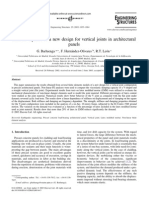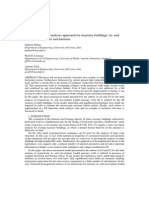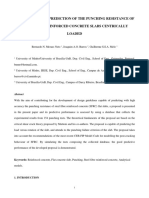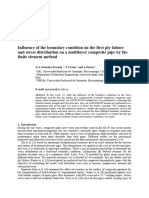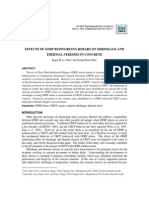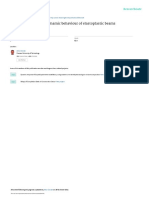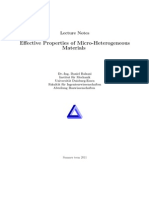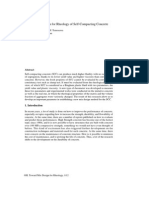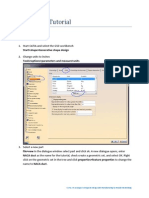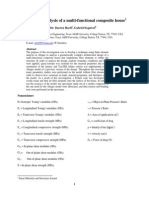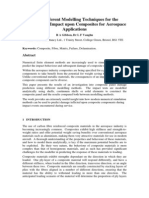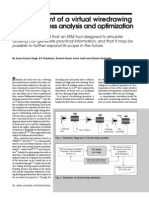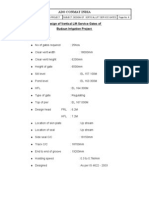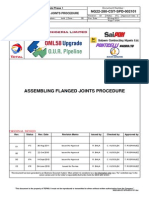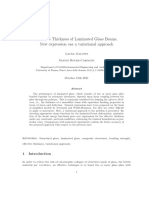Professional Documents
Culture Documents
A Micromechanics-Based Model For Stiffness and Strength Estimation of Cocciopesto Mortars
Uploaded by
zebra00Original Description:
Original Title
Copyright
Available Formats
Share this document
Did you find this document useful?
Is this content inappropriate?
Report this DocumentCopyright:
Available Formats
A Micromechanics-Based Model For Stiffness and Strength Estimation of Cocciopesto Mortars
Uploaded by
zebra00Copyright:
Available Formats
Acta Polytechnica Vol. 52 No.
6/2012
A Micromechanics-Based Model for Stiness and Strength Estimation
of Cocciopesto Mortars
Vclav Neerka, Jan Zeman
Department of Mechanics, Faculty of Civil Engineering, Czech Technical University in Prague, Thkurova 7, 166 29
Praha 6, Czech Republic
Corresponding author: vaclav.nezerka@fsv.cvut.cz, zemanj@cml.fsv.cvut.cz
Abstract
The purpose of this paper is to propose an inexpensive micromechanics-based scheme for stiness homogenization and
strength estimation of mortars containing crushed bricks, known as cocciopesto. The model utilizes the Mori-Tanaka
method for determining the eective stiness, combined with estimates of quadratic invariants of the deviatoric stresses
inside phases to predict the compressive strength. Special attention is paid to the representation of the C-S-H gel layer
around bricks and the interfacial transition zone around sand aggregates, which renders the predictions sensitive to particle
sizes. Several parametric studies are performed to demonstrate that the method correctly reproduces the data and trends
reported in the available literature. Moreover, the model is based exclusively on parameters with a clear physical or
geometrical meaning, and as such it provides a convenient framework for its further experimental validation.
Keywords: micromechanics, homogenization, strength estimation, cocciopesto, C-S-H gel coating, interfacial transition
zone.
1 Introduction
The use of lime as a binder in mortars is associated
with well-known inconveniences, such as slow setting
and carbonation, high drying shrinkage and porosity,
and low mechanical strength [1]. Although these limi-
tations have been overcome with the use of Portland
cement in the last 50 years, lime mortars still nd use
in the restoration of historic structures. This is mainly
due to their superior compatibility with the original
materials, in contrast to many modern renovation
render systems, e.g. [16, 17, 29].
The mechanical properties of lime mortars can
be improved by the suitable design of the mixture.
The Phoenicians were probably the rst ones to add
crushed clay products, such as burnt bricks, tiles or
pieces of pottery, to lime mortars to increase their
durability and strength. The Romans called this
material cocciopesto and utilized this mortar in ar-
eas where other natural pozzolans were not avail-
able. Cocciopesto-based structures exhibit increased
ductility, leading to their remarkable resistance to
earthquakes [3, 21].
Much later, it was found that the mortars contain-
ing crushed clay bricks, burnt at 600900C, exhibit
a hydraulic character, manifested by the formation
of a thin layer of Calcium-Silicate-Hydrate (C-S-H)
gel at the lime-brick interface [20]. Since C-S-H gel is
the key component responsible for the favorable me-
chanical performance of Portland cement pastes [23],
it is generally conjectured that the enhanced perfor-
mance of cocciopesto mortars can be attributed to
the high strength and stiness of the C-S-H gel coat-
ing [3, 20, 21, 29]. This mechanism competes with
the formation of the Interfacial Transition Zone (ITZ)
at the matrix-aggregate interface, which is known to
possess higher porosity and thus lower stiness in
cement-based mortars, e.g. [24, 28, 36].
The purpose of this work is to interpret these
experimental ndings by a micromechanical model
based on the Mori-Tanaka method [19], motivated
by its recent applications to related material sys-
tems. These include estimates of the eective ther-
mal conductivity of rubber-reinforced cement compos-
ites [31], elasticity predictions for early-age cement [5]
or alkali-activated [35] pastes, upscaling the compres-
sive strength of cement mortars [26], and multi-scale
simulations of three-point bending tests of concrete
specimens [34]. Here, we exploit these developments
to propose a simple analytical model for a stiness
and strength estimation of cocciopesto mortars in
Section 2. In particular, the elasticity predictions uti-
lize Benvenistes reformulation [4] of the Mori-Tanaka
method [19], whereas the strength predictions build
on recent results by Pichler and Hellmich [26], who
demonstrated that compressive strength is closely re-
lated to the quadratic average of the deviatoric stress
in the weakest phase. Particular attention is paid
to representation of the coatings by C-S-H gel and
ITZ, which renders the predictions sensitive to the
size of the brick particles and aggregates. In Section 3,
we verify predictions of the proposed scheme against
data available in the open literature. These nding
are summarized in Section 4, mainly as a support for
29
Acta Polytechnica Vol. 52 No. 6/2012
matrix (0)
brick (2)
void (1)
sand (4)
ITZ (5)
C-S-H (3)
Figure 1: Scheme of the micromechanics-based
model. The numbers in parentheses refer to the in-
dexes of the individual phases.
future validation of the model against experimental
results. Finally, in Appendix A we gather technical
details needed to account for coated inclusions in order
to make the paper self-contained.
In what follows, the Mandel representation of sym-
metric tensorial quantities is systematically employed,
e.g. [18, p. 23]. In particular, italic letters, e.g. a
or A, refer to scalar quantities, and boldface letters,
e.g. a or A, denote vectors or matrix representations
of second- or fourth-order tensors. A
T
and (A)
1
standardly denote the matrix transpose and the in-
verse matrix. Other symbols and abbreviations are
introduced in the text when needed.
2 Model
We consider a composite sample occupying domain ,
composed of n distinct phases indexed by r. The value
r = 0 is reserved for the matrix phase and r = 1, . . . , n
refer to heterogeneities having the shape of a sphere
or spherical shell, see Fig. 1. The volume fraction of
the r-th phase is dened as c
(r)
= |
(r)
|/||, where
|
(r)
| denotes the volume occupied by the r-th phase,
and the geometry of the coated particles is specied
by their radii R
(r)
for r = 2, . . . , 5, Fig. 2.
Several comments are in now order concerning sim-
plications adopted in the model. First, brick particles
and voids are considered spherical in shape, instead
of more realistic ellipsoids, as in e.g. [27, 26]. This
step is known to introduce only minor errors in the
prediction of overall transport [31] or elastic [27] prop-
erties. As demonstrated by Pichler et al. [27], the
up-scaled strength is more sensitive to the shape of
inhomogeneities, but the model is still capable of pre-
dicting the correct trends. Second, the ITZ is taken as
homogeneous and is not resolved down to the level of
microheterogeneities. This arises as a result of the fact
that, in contrast to cement-based materials [24, 28],
we are currently not aware of any work studying the
structure of ITZ in lime-based mortars, thus input
data for a more detailed representation is not available.
Third, only monodisperse distribution of particles in
assumed. Polydispersivity can be incorporated by sim-
ple averaging arguments and results only in a moderate
increase in accuracy [31, and references therein].
The elastic properties of the individual phases are
specied by the material stiness matrix L
(r)
. As each
phase is assumed to be homogeneous and isotropic,
we have
L
(r)
= 3K
(r)
I
V
+ 2G
(r)
I
D
for r = 0, . . . , n, (1)
where K
(r)
and G
(r)
are the bulk and shear moduli of
the r-th phase, and I
V
and I
D
denote the orthogonal
projections to the volumetric and deviatoric compo-
nents, e.g. [13], so that
(x) = (I
V
+I
D
)(x) =
V
(x)1 +
D
(x), (2a)
(x) = (I
V
+I
D
)(x) =
V
(x)1 +
D
(x), (2b)
for x . In Eq. (2), and refer to local stresses
and strains,
V
and
D
are the volumetric and devia-
toric strain components,
V
and
D
refer to the stress
components, and 1 is the second-order unit tensor (in
the matrix representation).
The development of the model follows the standard
routine of the continuum micromechanics, e.g. [37].
The sample is subjected to the overall strain loading
E. Neglecting the interaction among the phases, the
mean strains inside the heterogeneities are obtained
as
E
(r)
= A
(r)
dil
E for r = 1, . . . , n,
where A
(r)
dil
is the dilute concentration factor of the r-th
phase, see Section 2.1. In Section 2.2, after accounting
for the phase interaction, these are combined to the
full concentration factors satisfying
E
(r)
= A
(r)
E for r = 0, . . . , n,
utilized next to estimate the overall stiness of the
composite material, L
e
. Moreover, as outlined in Sec-
tion 2.3, the expression for the overall stiness also
encodes the mean value of the quadratic invariant of
the local stress deviator
D
, dened as
J
(r)
2
=
1
2|
(r)
|
_
(r)
D
(x)
T
D
(x) dx, (3)
which can be directly used to estimate the overall
strength of a material.
2.1 Dilute concentration factors
Due to the geometrical and material isotropy of the
individual phases, the dilute concentration factors
attain a form analogous to (1):
A
(r)
dil
= A
(r)
dil,V
I
V
+ A
(r)
dil,D
I
D
for r = 1, . . . , n. (4)
30
Acta Polytechnica Vol. 52 No. 6/2012
(i
3
)
(i
1
)
(i
2
)
R
(i
1
)
R
(i
2
)
Figure 2: Scheme of a single-layer inclusion
The expressions for the components are given sep-
arately for the uncoated (r = 1) and coated (r =
2, . . . , 5) particles. Namely, in the rst case it holds
A
(1)
dil,V
=
K
(0)
K
(0)
+
(0)
(K
(1)
K
(0)
)
,
A
(1)
dil,D
=
G
(0)
G
(0)
+
(0)
(G
(1)
G
(0)
)
,
with the auxiliary factors following from the Eshelby
solution [9] in the form
(0)
=
1 +
(0)
3(1 +
(0)
)
,
(0)
=
2(4 5
(0)
)
15(1
(0)
)
,
where
(0)
is the Poisson ratio of the matrix phase.
The coated case is more involved, and was rst
solved in its full generality by Herve and Zaoui [10]
for a multi-layered spherical inclusion. To apply their
results in the current setting, we locally number the
phases by the index i = [i
1
, i
2
, i
3
]
T
, see Fig. 2, where
i = [2, 3, 0]
T
for the brickC-S-H conglomerate and
i = [4, 5, 0]
T
refers to a sand particle coated by ITZ.
Now, we have
A
(i
1
)
dil,V
=
1
Q
2
11
, A
(i
2
)
dil,V
=
Q
1
11
Q
2
11
, (5)
and
A
(i
1
)
dil,D
= A
1
21
5
R
(i
1
)2
1 2
(i
1
)
B
1
, (6)
A
(i
2
)
dil,D
= A
2
21
5
R
(i
2
)5
R
(i
2
1)5
(1 2
(i
2
)
)(R
(i
2
)3
R
(i
2
1)3
)
B
2
,
where the auxiliary factors are provided in Ap-
pendix A.
2.2 Stiness estimates
In Benvenistes [4] interpretation of the original Mori-
Tanaka method [19], the mutual interaction among
the heterogeneities is modeled by loading each particle
by the average strain in the matrix phase E
(0)
instead
of E. For this purpose, we relate E
(0)
to E by a
strain compatibility condition, valid under the dilute
approximation,
E =
_
c
(0)
I +
n
r=1
c
(r)
A
(r)
dil
_
E
(0)
,
from which we express the full concentration factors
as
A
(0)
=
_
c
(0)
I +
n
r=1
c
(r)
A
(r)
dil
_
1
,
A
(r)
= A
(r)
dil
A
(0)
for r = 1, . . . , n.
Utilizing a universal relation
L
e
=
n
r=0
c
(r)
L
(r)
A
(r)
,
we can see that the eective stiness inherits the
symmetry of individual phases (1) with
K
e
=
c
(0)
K
(0)
+
n
r=1
c
(r)
K
(r)
A
(r)
dil,V
c
(0)
+
n
r=1
c
(r)
A
(r)
dil,V
, (7a)
G
e
=
c
(0)
G
(0)
+
n
r=1
c
(r)
G
(r)
A
(r)
dil,D
c
(0)
+
n
r=1
c
(r)
A
(r)
dil,D
. (7b)
2.3 Strength estimates
As was rst recognized by Kreher [14], the uctuations
of the stresses and strains in individual phases can be
estimated from the energy conservation condition due
to Hill [11]:
E
T
L
e
E =
1
||
n
r=0
_
9K
(r)
_
(r)
2
V
(x) dx
+
_
(r)
2G
(r)
T
D
(x)
D
(x) dx
_
,
(8)
expressing the conservation of energy on the
macroscale due to E and the average local values
due to
V
and
D
. Dierentiating (8) with respect to
G
(r)
, we obtain
E
T
L
e
G
(r)
E =
2
||
_
(r)
T
D
(x)
D
(x) dx,
for r = 0, . . . , n. Next, we recognize that
(r)
D
=
(1/2G
(r)
)
(r)
D
and recall the denition of the quadratic
invariant (3) to arrive at
J
(r)
2
= G
(r)
_
1
c
(r)
E
T
L
e
G
(r)
E. (9)
As was thoroughly demonstrated by Pichler et
al. [27] and Pichler and Hellmich [26], this quantity
is closely related to the compressive strength f
c
of
31
Acta Polytechnica Vol. 52 No. 6/2012
.
Table 1: Reference properties of individual phases; denotes mass density, f
t
is tensile
strength, m is the mass fraction, and radii R are dened according to Fig. 2
r Phase E f
t
m R Note
[kgm
3
] [MPa] [-] [MPa] [-] [m]
0 Pure lime matrix 1200
a
2000
[8]
0.25
[8]
0.4
[8]
3
1 Voids 10
9
0.25 0.1100
[22]
c
(1)
= 35%
a
2 Clay brick 2300
a
5000
a
0.17
a
3.2
a
1 500
3 C-S-H gel 2000
[12]
22000
[7]
0.2
[7]
510
[6]
4 Siliceous sand 2700
a
60000
[34]
0.17
[34]
48
[23]
1 500
5 ITZ 1200
b
500
c
0.25
b
520
c
a
Our own (unpublished) data. Densities and porosity were measured by a pycnometer,
elastic constants were determined from strain-gauge data in a compression test, and the
tensile strength follows from a unidirectional tensile test.
b
Same value as for the lime matrix.
c
Set as in [36] for cement-based concretes, i.e., Youngs modulus to 2040% of the value
for the matrix phase and thickness to 20 m.
cement pastes at various degrees of hydration. Here,
we postulate that
f
c
(p
1
)
f
c
(p
2
)
J
(w)
2
(p
2
)
J
(w)
2
(p
1
)
, (10)
where w = 0, . . . , n is the index of the weakest phase
and p refers to a parameter characterizing the mix-
ture composition, see the next section for concrete
examples.
3 Results and discussion
The purpose of this section is to examine the trends
in mechanical properties as predicted by the proposed
scheme. The default data for individual phases, sum-
marized in Table 1, were assembled from open litera-
ture and complemented with our own, yet unpublished,
measurements. Note that the matrixbricksand frac-
tions correspond to a typical composition of historic
lime mortars [3, 2], and that the engineering constants
E and are connected to the bulk and shear moduli
through well-known relations, e.g. [18, p. 23],
K =
E
3(1 2)
, G =
E
2(1 + )
.
Given the data in Table 1, the volume fractions of
individual phases are determined from six independent
conditions. The rst two relate the volume fractions
of brick and sand particles and their coatings by
c
(3)
=
_
_
R
(3)
R
(2)
_
3
1
_
c
(2)
, c
(5)
=
_
_
R
(5)
R
(4)
_
3
1
_
c
(4)
.
Next, we enforce the value of mass fractions via
c
(0)
=
m
(0)
(2)
m
(2)
(0)
c
(2)
, c
(0)
=
m
(0)
(4)
m
(4)
(0)
c
(4)
,
where m
(r)
and
(r)
denote the mass fraction and the
mass density of the r-th phase, respectively. Since
c
(1)
is given, the remaining condition is provided by
5
r=0
c
(r)
= 1, and the phase volume fractions follow
as the solution of the system of 6 6 linear equations.
In the sensitivity analyses, motivated by experi-
mental ndings in e.g. [3, 33, 32], we assume that an
increase in the C-S-H gel volume fraction (c
(3)
) is
compensated by the corresponding changes for ma-
trix (c
(0)
), voids (c
(1)
), and clay bricks (c
(2)
), so
that
c
(0)
+ c
(1)
+ c
(2)
+ c
(3)
= 0,
where we set for simplicity c
(1)
= c
(2)
= c
(3)
. By
analogy, the increase in the volume fraction of ITZ
corresponds to the decrease in volume of the matrix
phase:
c
(0)
+ c
(5)
= 0.
In the strength estimates, the imposed loading
simulates the uniaxial compression test, for which
= [1, 0, 0, 0, 0, 0]
T
and the average strain follows
from
E = (L
e
)
1
.
We assume that ITZ is the weakest phase, i.e. w = 5
in Eq. (10), and, similarly to [27], we estimate the
derivative in Eq. (9) by the forward dierence with a
step size of G
(5)
= 1 Pa.
1
1
Our results are reproducible with a MATLAB code Ho-
mogenizator MT, freely available at http://mech.fsv.cvut.
cz/~nezerka/software.
32
Acta Polytechnica Vol. 52 No. 6/2012
0 10 20 30 40 50 60 70 80
0.75
0.8
0.85
0.9
0.95
1
C-S-H coating thickness t [m]
A
(
2
)
d
i
l
(
t
)
/
A
(
2
)
d
i
l
(
0
)
volumetric part
deviatoric part
0 10 20 30 40 50 60 70 80
0.75
0.8
0.85
0.9
0.95
1
ITZ coating thickness t [m]
A
(
4
)
d
i
l
(
t
)
/
A
(
4
)
d
i
l
(
0
)
volumetric part
deviatoric part
(a) (b)
Figure 3: Inuence of the coating thickness on the dilute concentration factors for (a) brick and (b) sand
particles. The vertical lines refer to the default thicknesses that are kept constant in the remaining sensitivity
analyses.
0 10 20 30 40 50
1000
2000
3000
4000
5000
porosity c
(1)
[%]
E
e
[
M
P
a
]
0 10 20 30 40 50
0.4
0.5
0.6
0.7
0.8
0.9
1
porosity c
(1)
[%]
f
c
(
c
(
1
)
)
/
f
c
(
0
)
(a) (b)
Figure 4: (a) Stiness-porosity and (b) strength-porosity relations.
3.1 Eect of coatings
The rst aspect that we would like to discuss is the
eect of the coating on the dilute concentration factors
of the brick and sand particles. Fig. 3 demonstrates
that, in terms of the volumetric phase strains, the
eects of C-S-H and ITZ are comparable, despite the
fact that the C-S-H is stier and ITZ is more com-
pliant than the matrix phase. The dierences in the
deviatoric part, which drive the strength estimates
according to Eq. (10), become more pronounced with
the increasing thickness. This indicates that the con-
tribution of brick and sand particles to the overall
properties might still be dierent, after accounting
phase properties and their interaction, see Section 3.3
for a further discussion.
3.2 Inuence of porosity
By analogy with the cement pastes, porosity has a
major inuence on the overall properties of lime-based
mortars. This is conrmed by the results of the pro-
posed model, shown in Fig. 4. As for the overall
stiness, for the realistic range of porosities of 25
40% [8], the estimates (7) predict Young modulus
values between 2, 000 and 1, 000 MPa. This is con-
sistent with the values reported in [3] historic lime
mortars (without pozzolan admixtures).
As for the strength estimates, it follows from
Fig. 4 (b) that they reproduce a Power-law relation [23,
p. 280]
f
c
(c
(1)
) = f
c
(0)(1 c
(1)
)
n
, (11)
with n
.
= 1.04, yielding practically the linear strength-
porosity scaling. Unfortunately, we are currently un-
able to validate this prediction against experiments;
the only available work we are aware of by Papayianni
and Stefanidou [25] does not contain enough data.
Still, Eq. (11) complies with the fact that the inu-
ence of porosity is much smaller in lime mortars than
in cement-based materials [15, Section 2.6], for which
n 3 is typically used, see [25, and references therein].
3.3 Size eects
Now we proceed to clarify the impact of brick and sand
particles on the overall mechanical properties.
2
In par-
ticular, when the size of the brick particles increases,
the material becomes more compliant since the stien-
ing eect of the C-S-H layer decreases, Fig. 5(a). This
also increases the deviatoric stresses in ITZ, as mani-
fested by the strength reduction visible in Fig. 5(b).
These eects practically stabilize for particles larger
than 0.5 mm, and their magnitude is rather limited:
the stiness decreases by about 10 % and the strength
only by 4 %. Such trends are qualitatively consistent
with the results presented e.g. in [3, 21, 29].
Larger sand particles, on the other hand, tend to
make the composite material stier, Fig. 6(a), by
2
In the sensitivity analysis, the mass ratio is kept constant
according to Table 1.
33
Acta Polytechnica Vol. 52 No. 6/2012
0.3 0.6 0.9 1.2 1.5
900
1000
1100
1200
1300
1400
radius R
(2)
[mm]
E
e
[
M
P
a
]
0.3 0.6 0.9 1.2 1.5
0.95
0.96
0.97
0.98
0.99
1
radius R
(2)
[mm]
f
c
(
R
(
2
)
)
/
f
c
(
0
)
(a) (b)
Figure 5: Inuence of the brick particle size on the overall (a) stiness and (b) strength.
0 0.5 1 1.5
800
1000
1200
1400
1600
1800
radius R
(4)
[mm]
E
e
[
M
P
a
]
0 0.5 1 1.5
0.75
0.8
0.85
0.9
0.95
1
radius R
(4)
[mm]
f
c
(
R
(
4
)
)
/
f
c
(
0
)
(a) (b)
Figure 6: Inuence of the sand particle size on the overall (a) stiness and (b) strength.
compensating for the inferior mechanical properties
of the ITZ. Since the relative thickness of ITZ layer
decreases, the stresses inside this phase increase and
the material becomes weaker in overall, Fig. 6(b).
When compared to brick particles, these eects are
much more pronounced: in the considered range of
radii, the Young modulus increases by about 100 %
and the strength decreases by 25 % with no tendency
to stabilize. This agrees well with the experimental
outcomes reported in [30].
4 Conclusions
In the present work, following the recent developments
presented in [27, 26, 35, 34], a simple micromechanics-
based scheme for strength and stiness estimates of
cocciopesto mortars has been presented. The model
directly utilizes measurable material and geometrical
properties of individual phases and is free of adjustable
parameters. On the basis of the presented results, we
conclude that the model
1. predicts realistic values of the overall Young mod-
ulus and strength-porosity scaling,
2. captures the smaller is stier and smaller is
stronger trends for crushed brick particles,
3. captures the larger is stier and larger is
weaker trends for sand aggregates,
4. explains the positive role of crushed bricks in
comparison with sand aggregates.
Of course, in order for this model to be accepted
for practical use, it needs to be validated against
comprehensive experimental data at micro- and macro-
scales, and the role of ITZ in lime-based mortars
needs to be claried. This topic is currently under
investigation and will be reported separately.
Acknowledgements
We wish to thank an anonymous referee for a number
of valuable suggestions on the previous version of
the manuscript. This work was supported by the
Ministry of Culture of the Czech Republic, project
No. DF11P01OVV008.
References appear after the appendix on page 36.
34
Acta Polytechnica Vol. 52 No. 6/2012
The eect of coating on the mechanical properties enters the solution through the auxiliary factors Q
k
in Eq. (5),
and A
k
and B
k
in Eq. (6). Here, these are provided in the closed form optimized for coding, utilizing the results
and nomenclature by Herve and Zaoui [10]. Note that in order to keep the notation consistent, a
(k)
corresponds to
a property of the k-th phase, whereas a
k
denotes a quantity utilized in the Herve-Zaoui solution (independent of
a
(k)
). Also recall that we employ the local numbering of phases by the index i = [i
1
, i
2
, i
3
]
T
introduced by Fig. 2.
In particular, the volumetric part is expressed in terms of matrices
Q
1
= N
1
, Q
2
= N
2
Q
1
,
with
N
k
=
1
3K
(i
k+1
)
+ G
(i
k+1
)
_
_
3K
(i
k
)
+ 4G
(i
k+1
)
4
R
(i
k
)3
(G
(i
k+1
)
G
(i
k
)
)
3R
(i
k
)3
(K
(i
k+1
)
K
(i
k
)
) 3K
(i
k+1
)
+ 4G
(i
k
)
_
_
for k = 1, 2.
The matrices needed to evaluate the deviatoric part follow from
A
1
=
P
2
22
P
2
11
P
2
22
P
2
12
P
2
21
, A
2
= W
2
1
, B
1
=
P
2
21
P
2
11
P
2
22
P
2
12
P
2
21
, B
2
= W
2
2
,
where
W
k
=
1
P
2
22
P
2
11
P
2
12
P
2
21
P
k1
_
P
2
22
P
2
21
0 0
_
T
(k = 1, 2), P
1
= M
1
, P
2
= M
2
P
1
.
The auxiliary matrix M
k
admits the expression:
M
k
=
1
5(1
(i
k+1
)
)
_
_
c
k
3
R
(i
k
)2
(3b
k
7c
k
)
5(1 2
(i
k
)
)
12
k
R
(i
k
)5
4(f
k
27
k
)
15R
(i
k
)3
(1 2
(i
k
)
)
0
b
k
(1 2
(i
k+1
)
)
5(1 2
(i
k
)
)
M
k
23
12
k
(1 2
(i
k+1
)
)
7R
(i
k
)7
(1 2
(i
k
)
)
R
(i
k
)5
k
2
R
(i
k
)7
(2a
k
+ 147
k
)
70(1 2
(i
k
)
)
d
k
7
M
k
34
M
k
41
7
k
R
(i
k
)5
(1 2
(i
k+1
)
)
2(1 2
(i
k
)
)
0
e
k
(1 2
(i
k+1
)
)
3(1 2
(i
k
)
)
_
_
with
M
k
23
=
20
k
(1 2
(i
k+1
)
)
7R
(i
k
)7
, M
k
41
=
5
k
R
(i
k
)3
(1 2
(i
k+1
)
)
6
,
M
k
34
=
R
(i
k
)2
(105(1
(i
k+1
)
) + 12
k
(7 10
(i
k+1
)
) 7e
k
)
35(1 2
(i
k
)
)
,
and
a
k
=
G
(i
k
)
G
(i
k+1
)
(7 + 5G
(i
k
)
)(7 10G
(i
k+1
)
) (7 10G
(i
k
)
)(7 + 5G
(i
k+1
)
),
b
k
=
G
(i
k
)
G
(i
k+1
)
(7 + 5G
(i
k
)
) + 4(7 10G
(i
k
)
),
c
k
= (7 5G
(i
k+1
)
) + 2(4 5G
(i
k+1
)
)
G
(i
k
)
G
(i
k+1
)
,
d
k
= (7 + 5G
(i
k+1
)
) + 4(7 10G
(i
k+1
)
)
G
(i
k
)
G
(i
k+1
)
,
e
k
= 2(4 5G
(i
k
)
) +
G
(i
k
)
G
(i
k+1
)
(7 5G
(i
k
)
),
f
k
= (4 5G
(i
k
)
)(7 5G
(i
k+1
)
)
G
(i
k
)
G
(i
k+1
)
(4 5G
(i
k+1
)
)(7 5G
(i
k
)
),
k
=
G
(i
k
)
G
(i
k+1
)
1.
Appendix A: Herve-Zaoui solution
35
Acta Polytechnica Vol. 52 No. 6/2012
References
[1] A. Arizzi, G. Cultrone. Aerial lime-based mortars
blended with a pozzolanic additive and dier-
ent admixtures: A mineralogical, textural and
physical-mechanical study. Construction and
Building Materials 31:135143, 2012.
[2] G. Baronio, L. Binda. Study of the pozzolanic-
ity of some bricks and clays. Construction and
Building Materials 11:4146, 1997.
[3] G. Baronio, L. Binda, N. Lombardini. The role of
brick pebbles and dust in conglomerates based on
hydrated lime and crushed bricks. Construction
and Building Materials 11:3340, 1997.
[4] Y. Benveniste. A new approach to the application
of Mori-Tanaka theory in composite materials.
Mechanics of Materials 6:147157, 1987.
[5] O. Bernard, Ulm F.-J., E. Lemarchand. A mul-
tiscale micromechanics-hydration model for the
early-age elastic properties of cement-based ma-
terials. Cement and Concrete Research 33:1293
1309, 2003.
[6] H. Bke, S. Akkurt, B. peko glu, E. U gurlu. Char-
acteristics of brick used as aggregate in historic
brick-lime mortars and plasters. Cement and
Concrete Research 36:11151122, 2006.
[7] G. Constantinides, F.J. Ulm. The eect of two
types of C-S-H on the elasticity of cement-based
materials: Results from nanoindentation and mi-
cromechanical modeling. Cement and Concrete
Research 34:6780, 2004.
[8] M. F. Drdck, D. Michoinov. Lime mortars
with natural bres. In A. M. Brandt, V. C. Li,
I. H. Marshall (eds.), Brittle Matrix Composites 7:
Proceedings of the 7th International Symposium,
pp. 523532. Institute of Fundamental Techno-
logical Research, Woodhead Publishing Limited,
Cambridge, UK, 2003.
[9] J.D. Eshelby. The Determination of the Elastic
Field of an Ellipsoidal Inclusion, and Related
Problems. Proceedings of the Royal Society of
London 241:376396, 1957.
[10] E. Herve, A. Zaoui. n-layered inclusion-based mi-
cromechanical modelling. International Journal
of Engineering Science 31:110, 1993.
[11] R. Hill. Elastic properties of reinforced solids:
Some theoretical principles. Journal of the Me-
chanics and Physics of Solids 11(5):357372,
1963.
[12] J.T. Jerey, M.J. Hamlin. A colloidal interpreta-
tion of chemical aging of the C-S-H gel and its
eects on the properties of cement paste. Cement
and Concrete Research 36:3038, 2006.
[13] M. Jirsek. Basic concepts and equations of solid
mechanics. Revue Europenne de Gnie Civil
11:879892, 2007.
[14] W. Kreher. Residual stresses and stored elastic
energy of composites and polycrystals. Journal of
the Mechanics and Physics of Solids 38:115128,
1990.
[15] R.M.H. Lawrence. A study of carbonation in non-
hydraulic lime mortars. Ph.D. thesis, University
of Bath, 2006.
[16] P. Maravelaki-Kalaitzaki, A. Bakolas, A. Mo-
ropoulou. Physico-chemical study of Cretan an-
cient mortars. Cement and Concrete Research
33:651661, 2003.
[17] D. Michoniov. Questions about renovation plas-
ters. Zprvy pamtkov pe 65:313316, 2005.
In Czech.
[18] G. W. Milton. The Theory of Composites. Cam-
bridge Monographs on Applied and Computa-
tional Mathematics. Cambridge University Press,
2002.
[19] T. Mori, Tanaka K. Average stress in matrix and
average elastic energy of materials with mixtting
inclusions. Acta Metallurgica 21:571574, 1973.
[20] A. Moropoulou, A. Bakolas, K. Bisbikou. Charac-
terization of ancient, Byzantine and later historic
mortars by thermal and X-ray diraction tech-
niques. Thermochemica Acta 269/270:779995,
1995.
[21] A. Moropoulou, A.S. Cakmak, G. Biscontin,
et al. Advanced Byzantine cement based com-
posites resisting earthquake stresses: the crushed
brick/lime mortars of Justinians Hagia Sophia.
Construction and Building Materials 16(8):543
552, 2002.
[22] M.J. Mosquera, B. Silva, B. Prieto, E. Ruiz-
Herrera. Addition of cement to lime-based mor-
tars: Eect on pore structure and vapor transport.
Cement and Concrete Research 36:16351642,
2006.
[23] A.M. Neville. Properties of Concrete: Fourth
Edition. Longman, 1996.
[24] J.P. Ollivier, J. C. Maso, B. Bourdette. Interfacial
transition zone in concrete. Advanced Cement
Based Materials 2:3038, 1995.
36
Acta Polytechnica Vol. 52 No. 6/2012
[25] I. Papayianni, M. Stefanidou. Strength-porosity
relationships in lime-pozzolan mortars. Construc-
tion and Building Materials 20:700705, 2005.
[26] B. Pichler, C. Hellmich. Upscaling quasi-brittle
strength of cement paste and mortar: A multi-
scale engineering mechanics model. Cement and
Concrete Research 41:467476, 2011.
[27] B. Pichler, C. Hellmich, J. Eberhardsteiner.
Spherical and acicular representation of hydrates
in a micromechanical model for cement paste:
prediction of early-age elasticity and strength.
Acta Mechanica 203(3):137162, 2009.
[28] K.L. Scrivener, A.K. Crumbie, P. Laugesen. The
interfacial transition zone (ITZ) between cement
paste and aggregate in concrete. Interface Science
12:411421, 2004.
[29] A. Sepulcre-Aguilar, F. Hernndez-Olivares. As-
sessment of phase formation in lime-based mor-
tars with added metakaolin, Portland cement
and sepiolite, for grouting of historic masonry.
Cement and Concrete Research 40:6676, 2010.
[30] M. Stefanidou, I. Papayianni. The role of ag-
gregates on the structure and properties of lime
mortars. Cement & Concrete Composites 27:914
919, 2005.
[31] J. Strnsk, J. Vorel, J. Zeman, M. ejnoha.
Mori-Tanaka based estimates of eective ther-
mal conductivity of various engineering materials.
Micromachines 2:129149, 2011.
[32] E. Vejmelkov, M. Keppert, Z. Kerner, et al.
Mechanical, fracture-mechanical, hydric, thermal,
and durability properties of lime-metakaolin plas-
ters for renovation of historical buildings. Con-
struction and Building Materials 31:2228, 2012.
[33] A.L. Velosa, F. Rocha, R. Veiga. Inuence
of chemical and mineralogical composition of
metakaolin on mortar characteristics. Acta Geo-
dynamica et Geomaterialia 153:121126, 2009.
[34] J. Vorel, V. milauer, Z. Bittnar. Multiscale
simulations of concrete mechanical tests. Jour-
nal of Computational and Applied Mathematics
236:48824892, 2012.
[35] V. milauer, P. Hlavek, F. kvra, et al. Mi-
cromechanical multiscale model for alkali acti-
vation of y ash and metakaolin. Journal of
Materials Science 46:65456555, 2011.
[36] C.C. Yang. Eect of the transition zone on the
elastic moduli of mortar. Cement and Concrete
Research 28:727736, 1998.
[37] A. Zaoui. Continuum micromechanics: Survey.
Journal of Engineering Mechanics 128:808816,
2002.
37
You might also like
- Elastic-Plastic Analysis of R/C Coupled Shear Walls: The Equivalent Stiffness Ratio of The Tie ElementsDocument8 pagesElastic-Plastic Analysis of R/C Coupled Shear Walls: The Equivalent Stiffness Ratio of The Tie ElementsAurela Meço ZeqoNo ratings yet
- Statistical Modelling and Prediction of Compressive Strength of ConcreteDocument7 pagesStatistical Modelling and Prediction of Compressive Strength of ConcreteAbdur RahmanNo ratings yet
- Ijsmdo:20080317 9Document6 pagesIjsmdo:20080317 9Itx hamzaNo ratings yet
- Keywords Ključne Reči: Radetomic@ppt - Co.rsDocument6 pagesKeywords Ključne Reči: Radetomic@ppt - Co.rsmedica101No ratings yet
- Seismic Response VjointDocument10 pagesSeismic Response Vjointrt9221No ratings yet
- Materials: The Hardness and Strength Properties of WC-Co CompositesDocument22 pagesMaterials: The Hardness and Strength Properties of WC-Co CompositesheriyantiNo ratings yet
- Application of Physical and Mathematical Modelling in Underground ExcavationsDocument8 pagesApplication of Physical and Mathematical Modelling in Underground ExcavationsrannscribdNo ratings yet
- AsfDocument10 pagesAsfХаџи Предраг ЛукићNo ratings yet
- 4.1. Modelling Confinement in Concrete Columns and Bridge Piers Through 3D Nonlinear Finite Element AnalysisDocument8 pages4.1. Modelling Confinement in Concrete Columns and Bridge Piers Through 3D Nonlinear Finite Element AnalysisFaraaz FaisalNo ratings yet
- Numerical Analysis of Composite STEEL-CONCRETE PDFDocument16 pagesNumerical Analysis of Composite STEEL-CONCRETE PDFanhxuanqbNo ratings yet
- On The Nonlinear Elastic Properties of Textile Reinforced Concrete Under Tensile Loading Including Damage and CrackingDocument7 pagesOn The Nonlinear Elastic Properties of Textile Reinforced Concrete Under Tensile Loading Including Damage and Crackingal_frdNo ratings yet
- Composite Structures: Quantian Luo, Liyong TongDocument11 pagesComposite Structures: Quantian Luo, Liyong TongSaid DjaballahNo ratings yet
- Engineering Mechanics 2012: Determination of Burst Pressure of Thin-Walled Pressure VesselsDocument11 pagesEngineering Mechanics 2012: Determination of Burst Pressure of Thin-Walled Pressure VesselspajadhavNo ratings yet
- Buckling Behavior of Curved Composite Beams With Different Elastic Response in Tension and CompressionDocument10 pagesBuckling Behavior of Curved Composite Beams With Different Elastic Response in Tension and CompressionFox_oNe_7No ratings yet
- TP Aero 2021 Inter-Noise Mejdi Va Modeling of Aircraft StructuresDocument9 pagesTP Aero 2021 Inter-Noise Mejdi Va Modeling of Aircraft StructuresatifkhushnoodNo ratings yet
- Metals 10 00491 v2Document16 pagesMetals 10 00491 v2Nishar Alam Khan 19MCD0042No ratings yet
- Moment-Curvature Diagrams For Evaluation of Second Order Effects in RC ElementsDocument15 pagesMoment-Curvature Diagrams For Evaluation of Second Order Effects in RC ElementsShyam AwalNo ratings yet
- 004 - Role of Alkali-Resistant GlassfiberDocument13 pages004 - Role of Alkali-Resistant GlassfiberMujtaba RabahNo ratings yet
- Fractal Geometry and Fracture of Rock: (China Institute of Mining & Technology)Document10 pagesFractal Geometry and Fracture of Rock: (China Institute of Mining & Technology)Baga YoiceNo ratings yet
- ModulusDocument22 pagesModulusYvette OrbánNo ratings yet
- Interface / Interphase in Polymer NanocompositesFrom EverandInterface / Interphase in Polymer NanocompositesAnil N. NetravaliNo ratings yet
- DACHDocument8 pagesDACHMohammad Reza AzadiNo ratings yet
- 6940 21524 1 PBDocument10 pages6940 21524 1 PBSanthosh KumarNo ratings yet
- A Comparative Study of The Forming-Limit Diagram Next Term Models For Sheet SteelsDocument8 pagesA Comparative Study of The Forming-Limit Diagram Next Term Models For Sheet SteelsRaghav KhajuriaNo ratings yet
- A Kinematic Limit Analysis Approach For Masonry Buildings: In-And Out-Of-Plane Failure MechanismsDocument5 pagesA Kinematic Limit Analysis Approach For Masonry Buildings: In-And Out-Of-Plane Failure MechanismsAntonio Perez OrtizNo ratings yet
- Analysis The Effects of Lightweight Concrete in THDocument9 pagesAnalysis The Effects of Lightweight Concrete in TH429e10d421No ratings yet
- Strain Transfer FunctionDocument10 pagesStrain Transfer FunctionBeny AbdouNo ratings yet
- Size Effects in Structural Concrete: A Numerical ExperimentDocument11 pagesSize Effects in Structural Concrete: A Numerical ExperimentMohammad DaudNo ratings yet
- Elastic-Plastic Analysis For Surrounding Rock of Pressure Tunnel With Lining Based On Material Nonlinear SofteningDocument6 pagesElastic-Plastic Analysis For Surrounding Rock of Pressure Tunnel With Lining Based On Material Nonlinear SofteningfatimamolaeeNo ratings yet
- A Model For The Prediction of The Punching Resistance of Steel Fibre Reinforced Concrete Slabs Centrically LoadedDocument43 pagesA Model For The Prediction of The Punching Resistance of Steel Fibre Reinforced Concrete Slabs Centrically LoadedYusuf Ali SamiNo ratings yet
- FPFComposite JPCSA4 R1Document9 pagesFPFComposite JPCSA4 R1Adell FebriNo ratings yet
- Interpenetrating Phase Composites: Micromechanical ModellingDocument6 pagesInterpenetrating Phase Composites: Micromechanical ModellingLeon MishnaevskyNo ratings yet
- Strengthening of Concrete Beams Using Fiber-Reinforced PlasticsDocument7 pagesStrengthening of Concrete Beams Using Fiber-Reinforced PlasticsOttawa CanadaNo ratings yet
- Micromechanics of Crack Bridging in Fibre-Reinforced ConcreteDocument9 pagesMicromechanics of Crack Bridging in Fibre-Reinforced ConcreteTran Tuan KietNo ratings yet
- An Investigation Concerning Optimal Design of Solid Elastic PlatesDocument19 pagesAn Investigation Concerning Optimal Design of Solid Elastic Platescasoj29No ratings yet
- Effects of GFRP Reinforcing Rebars On Shrinkage and Thermal Stresses in ConcreteDocument8 pagesEffects of GFRP Reinforcing Rebars On Shrinkage and Thermal Stresses in ConcretemarkicivanNo ratings yet
- Numerical Analysis of Dynamic Behaviour of Elastoplastic BeamsDocument19 pagesNumerical Analysis of Dynamic Behaviour of Elastoplastic BeamsDaniel RodriguezNo ratings yet
- Effective Properties of Micro-Heterogeneous Materials: Lecture NotesDocument29 pagesEffective Properties of Micro-Heterogeneous Materials: Lecture NotesyusufcatiNo ratings yet
- Effective Properties of Micro-Heterogeneous Materials: Lecture NotesDocument58 pagesEffective Properties of Micro-Heterogeneous Materials: Lecture NotesyusufcatiNo ratings yet
- 2D and 3D Meso-Scale Finite Element Models For Ravelling Analysis of Porous Asphalt ConcreteDocument11 pages2D and 3D Meso-Scale Finite Element Models For Ravelling Analysis of Porous Asphalt ConcreteJesus G HNo ratings yet
- Multi-Directional Modeling of Crack Pattern in 2D R/C MembersDocument14 pagesMulti-Directional Modeling of Crack Pattern in 2D R/C MembersVicente Bergamini PugliaNo ratings yet
- Multi-Objective Optimization of Reinforced Concrete Frames: Matěj LepšDocument8 pagesMulti-Objective Optimization of Reinforced Concrete Frames: Matěj LepšxelmerxNo ratings yet
- Magazine of Civil Engineering: The Location of Supports Under The Monolithic Reinforced Concrete Slabs OptimizationDocument11 pagesMagazine of Civil Engineering: The Location of Supports Under The Monolithic Reinforced Concrete Slabs OptimizationBảo ChâuNo ratings yet
- Empirical Relationships BetweeDocument12 pagesEmpirical Relationships BetweethaironhydeNo ratings yet
- Pergamon: Int. J. Impact Enyno Vol. 16, No. 5/6, Pp. 801-831, 1995Document31 pagesPergamon: Int. J. Impact Enyno Vol. 16, No. 5/6, Pp. 801-831, 1995apmapNo ratings yet
- Rel EauxDocument11 pagesRel EauxrscrouchNo ratings yet
- Sólyom Sándor, Balázs L GyörgyBond Behaviour FRPDocument18 pagesSólyom Sándor, Balázs L GyörgyBond Behaviour FRPSameerNo ratings yet
- Static Resistance Bolted Circular Flange JointsDocument9 pagesStatic Resistance Bolted Circular Flange JointsBálint Vaszilievits-SömjénNo ratings yet
- PCFD 05Document8 pagesPCFD 05Saher SaherNo ratings yet
- Submit 2Document5 pagesSubmit 2dnourzadehNo ratings yet
- Higher Order Models On The Eigenfrequency Analysis and Optimal Design of Laminated Composite StructuresDocument17 pagesHigher Order Models On The Eigenfrequency Analysis and Optimal Design of Laminated Composite Structuresnii20597No ratings yet
- Rheological Modelling of Complex Fluids. I. The Concept of Effective Volume Fraction RevisitedDocument9 pagesRheological Modelling of Complex Fluids. I. The Concept of Effective Volume Fraction RevisitedodexNo ratings yet
- Fractal Modeling of Fluidic Leakage Through Metal Sealing SurfacesDocument19 pagesFractal Modeling of Fluidic Leakage Through Metal Sealing SurfacesAngNo ratings yet
- Projective Wonderful Models For Toric Arrangemen 2018 Advances in MathematicDocument20 pagesProjective Wonderful Models For Toric Arrangemen 2018 Advances in MathematicVernonNo ratings yet
- Oh SCC 1999 Mix PropotionDocument12 pagesOh SCC 1999 Mix PropotionabhaysshindeNo ratings yet
- 1 s2.0 S0167844217301088 MainDocument9 pages1 s2.0 S0167844217301088 Main朱志清No ratings yet
- Theoretical and Computational Analysis of Airport Flexible Pavements Reinforced With GeogridsDocument9 pagesTheoretical and Computational Analysis of Airport Flexible Pavements Reinforced With GeogridsKarim BenyoucefNo ratings yet
- Finite Element Stress Analysis of Brick-Mortar Masonry Under CompressionDocument6 pagesFinite Element Stress Analysis of Brick-Mortar Masonry Under CompressionAnonymous P8Bt46mk5INo ratings yet
- Matrix-Fracture Transfer Shape Factors For Dual-Porosity Simulators (Lim & Aziz)Document10 pagesMatrix-Fracture Transfer Shape Factors For Dual-Porosity Simulators (Lim & Aziz)consultariskaNo ratings yet
- Numerical Integration (Quadrature)Document3 pagesNumerical Integration (Quadrature)zebra00No ratings yet
- Ora As Roljab: Rc1:0111Mend::Illo11 L UerDocument1 pageOra As Roljab: Rc1:0111Mend::Illo11 L Uerzebra00No ratings yet
- Internally Pressurized Thick Cylinder: Numerical TestsDocument1 pageInternally Pressurized Thick Cylinder: Numerical Testszebra00No ratings yet
- Comp BeamDocument6 pagesComp Beamzebra00No ratings yet
- A Study of Failure Criteria of Variable Stiffness Composite PanelsDocument1 pageA Study of Failure Criteria of Variable Stiffness Composite Panelszebra00No ratings yet
- Rel Notes v161Document5 pagesRel Notes v161zebra00No ratings yet
- FGMDocument7 pagesFGMzebra00No ratings yet
- Liste Du Contenu2013 ScopusDocument6,834 pagesListe Du Contenu2013 Scopuszebra00No ratings yet
- 100 Impact Analysis of Fiber-ReinforcedDocument23 pages100 Impact Analysis of Fiber-Reinforcedzebra00No ratings yet
- Z CracksDocument62 pagesZ Crackszebra00No ratings yet
- NACA Duct TutorialDocument38 pagesNACA Duct Tutorialzebra00100% (1)
- Composites SummaryDocument26 pagesComposites SummaryIr AyenNo ratings yet
- 3D FEA of Shot Peening Process For Simulation and Research On Shot Peenig Process ParametersDocument8 pages3D FEA of Shot Peening Process For Simulation and Research On Shot Peenig Process Parameterszebra00No ratings yet
- 1devoir2009 RponseDocument4 pages1devoir2009 RponseMounir MahdadeNo ratings yet
- 6.1.1 Eigenvalue Analysis of A Piezoelectric Transducer: Abaqus Example Problems ManualDocument7 pages6.1.1 Eigenvalue Analysis of A Piezoelectric Transducer: Abaqus Example Problems Manualzebra00No ratings yet
- Research Paper - William - Scholten PDFDocument27 pagesResearch Paper - William - Scholten PDFzebra00No ratings yet
- Etk Material Curves 20121018Document16 pagesEtk Material Curves 20121018zebra00No ratings yet
- Hashin Failure CriteriaDocument2 pagesHashin Failure CriteriaPunith Ml50% (2)
- Gibbon FPDocument42 pagesGibbon FPzebra00No ratings yet
- Cohesive Modeling in ABAQUSDocument9 pagesCohesive Modeling in ABAQUSzebra00No ratings yet
- 10-31-06 Python Scripting in ABAQUSDocument17 pages10-31-06 Python Scripting in ABAQUSSathian SuwannoNo ratings yet
- Socio LinguisticsDocument14 pagesSocio LinguisticsReza HassanNo ratings yet
- Development of A Virtual Wiredrawing Tool For Process Analysis and OptimizationDocument7 pagesDevelopment of A Virtual Wiredrawing Tool For Process Analysis and OptimizationPhani KumarNo ratings yet
- Practice ProblemsDocument1 pagePractice ProblemsRaymart PaulNo ratings yet
- ME4291 Assignment 1 - FEA of Gripper BladeDocument5 pagesME4291 Assignment 1 - FEA of Gripper BladeLeonelNo ratings yet
- QCS 2010 Section 5 Part 11 ReinforcementDocument10 pagesQCS 2010 Section 5 Part 11 Reinforcementbryanpastor106No ratings yet
- Eswl PDFDocument22 pagesEswl PDFAdamNo ratings yet
- Advances in Drillpipe Fatigue ManagementDocument1 pageAdvances in Drillpipe Fatigue ManagementFares NaceredineNo ratings yet
- Day 3 PICHEDocument13 pagesDay 3 PICHEKuo Garol SarongNo ratings yet
- Design of Vertical Lift Service Gates of Budaun Irrigation ProjectDocument33 pagesDesign of Vertical Lift Service Gates of Budaun Irrigation ProjectVikash Yadav83% (6)
- Stresses Under Centric LoadingDocument12 pagesStresses Under Centric LoadingAngel Florence V. VillareNo ratings yet
- Notes Ch.2 Shearing Force and Bending MomentDocument24 pagesNotes Ch.2 Shearing Force and Bending MomentCCC ChowNo ratings yet
- Topology Optimization of A Jet Engine Bracket Using SolidworksDocument46 pagesTopology Optimization of A Jet Engine Bracket Using SolidworksAhmedNo ratings yet
- Pressure Transducer DesignDocument112 pagesPressure Transducer DesignSumeet GhodkeNo ratings yet
- Analysis of Flexible Pavement Designed: Abu Hozaifa, Akash Gautam, Amit Kumar, Deependra Singh, Mohd ShariqDocument9 pagesAnalysis of Flexible Pavement Designed: Abu Hozaifa, Akash Gautam, Amit Kumar, Deependra Singh, Mohd ShariqAnaNo ratings yet
- Design of Leg & Skirt Per EN 13445-3 - 2009 PDFDocument17 pagesDesign of Leg & Skirt Per EN 13445-3 - 2009 PDFtranhonghakd5533100% (1)
- Int. J. Multiphase Flo "Document17 pagesInt. J. Multiphase Flo "M.RNo ratings yet
- Experimental Analysis of Property Variation in Biaxially Oriented Polypropylene Filmcbsx30 Eh During StorageDocument8 pagesExperimental Analysis of Property Variation in Biaxially Oriented Polypropylene Filmcbsx30 Eh During StorageAmna liaquatNo ratings yet
- Assembling Flanged Joints Procedure1Document34 pagesAssembling Flanged Joints Procedure1Ndomadu100% (3)
- Buckling Analysis of Cylindrical ShellsDocument4 pagesBuckling Analysis of Cylindrical ShellsVPN NetworkNo ratings yet
- Holistic Design of HTHP Pipeline: PETRONAS' ExperienceDocument20 pagesHolistic Design of HTHP Pipeline: PETRONAS' ExperienceDimas HaryoNo ratings yet
- Effective Thickness of Laminated Glass BeamsDocument32 pagesEffective Thickness of Laminated Glass BeamsJake YalongNo ratings yet
- Me212: Mechanics of Deformable Bodies: Course TitleDocument38 pagesMe212: Mechanics of Deformable Bodies: Course TitleASHISH PATILNo ratings yet
- Ada192205-Advanced Material Gun BarrelsDocument296 pagesAda192205-Advanced Material Gun Barrelszc lNo ratings yet
- Fluidsummary 180610171918 PDFDocument190 pagesFluidsummary 180610171918 PDFsing_r100% (1)
- Determination of Allowable StressesDocument7 pagesDetermination of Allowable Stressesvikas2510No ratings yet
- MSC Apex - StructureDocument2 pagesMSC Apex - StructureAmr EmadNo ratings yet
- ABS Rules For Building and Classing Steel Vessel, 2017: AlignmentDocument6 pagesABS Rules For Building and Classing Steel Vessel, 2017: AlignmentDavid MestanzaNo ratings yet
- Lintech Conveyor Pulleys: Corporation - LimitedDocument11 pagesLintech Conveyor Pulleys: Corporation - LimitedJr RonaldeyriNo ratings yet
- Assignment 02Document2 pagesAssignment 02adhnan_rasheed0% (1)
- D 5449 - D 5449m - 93 r00 Rdu0ndkvrdu0ndlnDocument9 pagesD 5449 - D 5449m - 93 r00 Rdu0ndkvrdu0ndlnJuanNo ratings yet
- Turbine BladeDocument19 pagesTurbine BladeParvin SurwadeNo ratings yet




